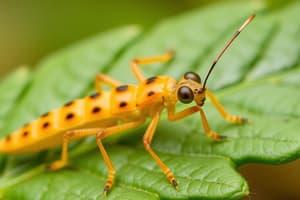Podcast
Questions and Answers
What is the internationally agreed system in which the scientific name of an organism is made up of two parts?
What is the internationally agreed system in which the scientific name of an organism is made up of two parts?
- Classificatory system
- Phylogenetic system
- Taxonomic system
- Binomial system (correct)
Who introduced a taxonomic hierarchy of classification and is known as the father of taxonomy?
Who introduced a taxonomic hierarchy of classification and is known as the father of taxonomy?
- Gregor Mendel
- Charles Darwin
- Alfred Wallace
- Carolus Linnaeus (correct)
What are the three domains in the taxonomic hierarchy of classification?
What are the three domains in the taxonomic hierarchy of classification?
- Monera, Protista, and Plantae
- Prokaryotes, eukaryotes, and viruses
- Archaea, bacteria, and eukarya (correct)
- Protists, fungi, and plants
What is the science of naming, identifying, and classifying organisms known as?
What is the science of naming, identifying, and classifying organisms known as?
Which characteristic of living things refers to the process of breaking down food to release energy?
Which characteristic of living things refers to the process of breaking down food to release energy?
What is a useful tool for scientists working in areas such as agriculture, forestry, and medicine?
What is a useful tool for scientists working in areas such as agriculture, forestry, and medicine?
What is the term for the way of sorting organisms into a meaningful order using morphology and DNA?
What is the term for the way of sorting organisms into a meaningful order using morphology and DNA?
In the scientific name of an organism, which part starts with a capitalized letter?
In the scientific name of an organism, which part starts with a capitalized letter?
The taxonomic hierarchies include domains, species, and class.
The taxonomic hierarchies include domains, species, and class.
Taxonomy is primarily concerned with the study of relationships between living and extinct organisms.
Taxonomy is primarily concerned with the study of relationships between living and extinct organisms.
In the binomial system, the specific name of an organism starts with a capitalized letter.
In the binomial system, the specific name of an organism starts with a capitalized letter.
Archaea, bacteria, and eukarya are the three domains in the taxonomic hierarchy of classification.
Archaea, bacteria, and eukarya are the three domains in the taxonomic hierarchy of classification.
Respiration refers to the process of breaking down food to release energy.
Respiration refers to the process of breaking down food to release energy.
The scientific names of organisms should be italicized when handwritten.
The scientific names of organisms should be italicized when handwritten.
Carolus Linnaeus is known as the father of taxonomy and introduced a taxonomic hierarchy of classification.
Carolus Linnaeus is known as the father of taxonomy and introduced a taxonomic hierarchy of classification.
Nutrition is not considered as one of the characteristics of living things.
Nutrition is not considered as one of the characteristics of living things.
The characteristics of living things are movement, respiration, sensitivity, growth, reproduction, excretion, nutrition, etc. Classification is a way of sorting organisms into a meaningful order, traditionally using morphology and anatomy, but recently also using DNA (molecular). The science of naming, identifying and classifying organisms is known as ______.
The characteristics of living things are movement, respiration, sensitivity, growth, reproduction, excretion, nutrition, etc. Classification is a way of sorting organisms into a meaningful order, traditionally using morphology and anatomy, but recently also using DNA (molecular). The science of naming, identifying and classifying organisms is known as ______.
Carolus Linnaeus (1707–1778), who is also known as the father of ______, introduced a taxonomic hierarchy of classification. The taxonomic hierarchies are domains, kingdom, Phylum (division), class, order, family, genus, and species The three domains are archaea, bacteria and eukarya (i.e.protists, fungi, plants and animals) Classification gives biologists a framework that allows them to study the relationships between living and extinct organisms. Taxonomy can be a useful tool for scientists who work in such areas as agriculture, forestry, and ______.
Carolus Linnaeus (1707–1778), who is also known as the father of ______, introduced a taxonomic hierarchy of classification. The taxonomic hierarchies are domains, kingdom, Phylum (division), class, order, family, genus, and species The three domains are archaea, bacteria and eukarya (i.e.protists, fungi, plants and animals) Classification gives biologists a framework that allows them to study the relationships between living and extinct organisms. Taxonomy can be a useful tool for scientists who work in such areas as agriculture, forestry, and ______.
The binomial system is an internationally agreed system in which the scientific name of an organism is made up of two parts showing the genus and the specific ______.
The binomial system is an internationally agreed system in which the scientific name of an organism is made up of two parts showing the genus and the specific ______.
In writing a scientific name, the first letter of name of the genus is a capitalized letter and the specific name always starts with a small letter, for example, the scientific name of human beings is Homo ______.
In writing a scientific name, the first letter of name of the genus is a capitalized letter and the specific name always starts with a small letter, for example, the scientific name of human beings is Homo ______.
The scientific names are underlined when handwritten or italicized when ______.
The scientific names are underlined when handwritten or italicized when ______.
The taxonomic hierarchies include domains, kingdom, Phylum (division), class, order, family, genus, and ______.
The taxonomic hierarchies include domains, kingdom, Phylum (division), class, order, family, genus, and ______.
Classification is a way of sorting organisms into a meaningful order, traditionally using morphology and anatomy, but recently also using DNA (molecular).The science of naming, identifying and classifying organisms is known as ______.
Classification is a way of sorting organisms into a meaningful order, traditionally using morphology and anatomy, but recently also using DNA (molecular).The science of naming, identifying and classifying organisms is known as ______.
The taxonomic hierarchies are domains, kingdom, Phylum (division), class, order, family, genus, and ______.
The taxonomic hierarchies are domains, kingdom, Phylum (division), class, order, family, genus, and ______.




